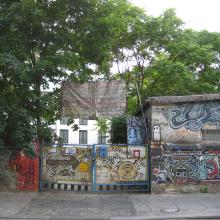Mitte
The Mitte neighborhood—the “middle” or center of the city—was overhauled by private and public investment since unification. Previously in East Berlin, most of the area was in various degrees of decay until 1990. After unification, the center of the city, which housed some of its oldest and most prestigious buildings and institutions (the Museum Island, the Humboldt University, the State Opera, the Brandenburg Gate), became a prized space for the concrete and symbolic reconstruction of the city as capital of the unified country. A center for tourism, culture, commerce, political power, and development, the Mitte became, in the words of scholar Andrej Holm, “super gentrified.” But before supergentrification took over, the Mitte had been an epicenter of alternative culture: squats, cultural and art occupations, illegal parties and nightclubs, art galleries. They took advantage of empty buildings, vacant lots, and derelict spaces that offered the potential for creative and unusual installations, uses, and settings. With time, most of these squats and occupations were displaced by new development. The Brunnen 183, evicted in 2009, was one of the longest-lasting squats in the area; it is pictured here in 2010, several months after its eviction. The Linie 206 began to be evicted in the Spring of 2016; the photos shown here are from 2010.






